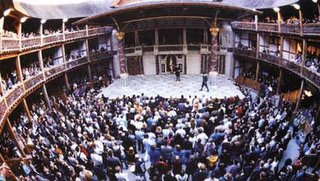Most students in the English-speaking world have studied and mostly loved (but sometimes hated)
William Shakespeare (never mind, as we
mentioned before, he actually wrote his plays or not ).
As a teacher of English myself, I find the following information (taken from
York Notes Advanced) a very illuminating way to contextualize Elizabethan theater for my students. It is also something that helps each one of us put the plays in the right perspective.
Modern fiction and drama are, by and large, realistic; they seek to persuade us that we are reading or watching what is really happening. There is a great deal of psychological accuracy in Shakespeare’s plays, but we are far from any attempt at realism.
we are far from any attempt at realism.
In modern theatre there is no communication between the audience and the stage, but in Elizabethan theatre, this distinction did not exist for 2 reasons
- the performance took place in the open air and in the daylight
- the spectators were all around the stage and they were dressed no differently than the actors who wore contemporary dress.
As a result they could not lose their identity in a corporate group, nor could they forget that they were spectators at a performance.
Besides, the Elizabethan audiences had none of our deference: they did not keep quiet, or arrive on time or remain during the whole performance.
As a result the Elizabethan theater utilized its very theatricality. The plays acknowledge the presence of the audience. It is addressed not only by prologues, epilogues and choruses, but also in soliloquies. (there is no realistic reason why characters should suddenly explain themselves to empty rooms. Soliloquies are not addressed to the world of the play but to the audience – and the audience’s complicity is assumed.So the plays are aware of themselves as dramas – they are self-reflective
 we are far from any attempt at realism.
we are far from any attempt at realism.
0 Comments:
Post a Comment
<< Home